1. Georges Seurat: Bathers at Asnieres (1884)
"Bathers at Asnières" was painted by Frenchman Georges Seurat between 1884 and 1887, depicting a suburb of Paris called Asnières-sur-Seine.
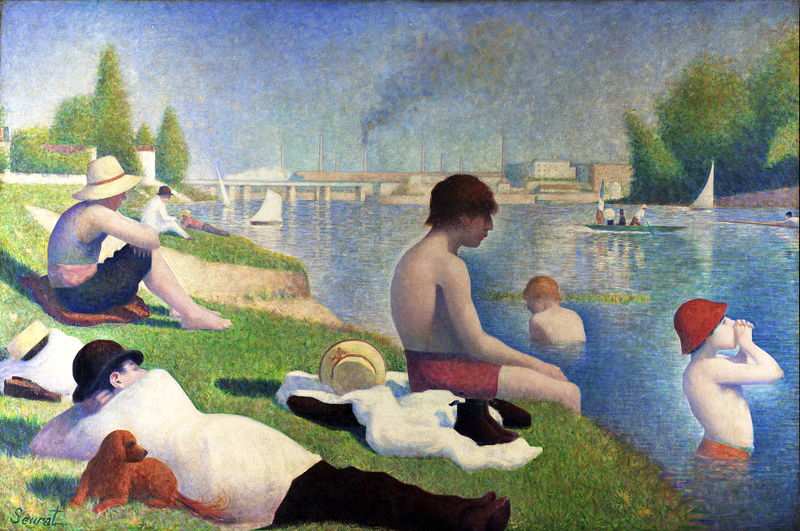
Key features of "Bathers at Asnières" are as follows:
- Style and Technique: Seurat employed a meticulous technique in this painting, using small dots or dabs of pure colour to create the image. He believed that by placing these tiny points of colour next to each other, they would be visually blended by the viewer's eye, resulting in more vibrant and luminous colours than traditional mixing on the palette.
- Subject Matter: The painting depicts a group of working-class young men who are enjoying a leisurely afternoon by the Seine River in Asnières. The figures are shown in a relaxed and contemplative manner, lounging on the grass or sitting by the water's edge. The scene is set against an industrial backdrop, with factories and smokestacks in the distance.
- Social Commentary: "Bathers at Asnières" can be seen as a commentary on the changing nature of urban life and the impact of industrialisation on society. The juxtaposition of the leisure activities of the working-class figures and the industrial landscape hints at the contrast between the hardships of everyday life and the desire for relaxation and escapism.
- Colour and Light: Seurat was interested in the scientific study of colour and its perception. He explored how the eye perceives colour through the juxtaposition of small dots of contrasting colours. This technique, known as "optical mixing," allowed him to achieve a vibrant and dynamic visual effect. The painting captures the interplay of light on the water, the figures' bodies, and the surrounding landscape.
- Influence and Legacy: "Bathers at Asnières" showcases Seurat's innovative approach to painting and his interest in exploring the relationship between colour and light. The Pointillist technique he used in this painting had a significant impact on the development of modern art. It laid the foundation for subsequent artistic movements, including Fauvism and even elements of Cubism.
The painting is currently held at the National Gallery in London and is regarded as one of Seurat's most celebrated works. It offers a glimpse into the artist's experimentation with colour theory and his ability to capture both the mundane and the profound aspects of life in the changing urban landscape of 19th-century Paris.
2. Georges Seurat: La Grande Jatte (1884-86)
"Sunday Afternoon on the Island of La Grande Jatte", commonly referred to as "La Grande Jatte", was painted between 1884-1886 and measures an enormous 81.7 x 121.25 inches (207 x 308 cm).
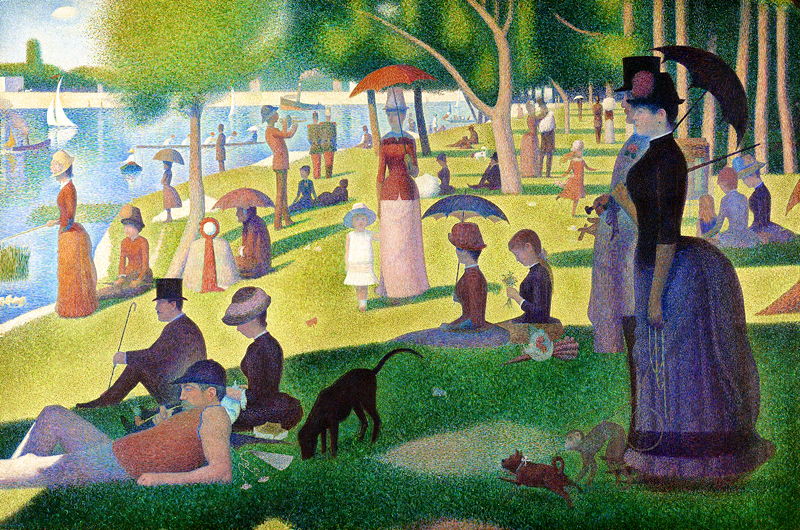
The painting depicts a scene in a park on the banks of the River Seine in Paris. It features a meticulously arranged group of people—men, women, children, and even some animals—occupying the park on a sunny Sunday afternoon.
The figures are shown in various poses, engaged in different activities such as strolling, sitting, and conversing. The composition of the painting is carefully structured, with a central horizontal axis and a balanced arrangement of figures that lends a sense of order to the scene.
Seurat's use of colour and light in "La Grande Jatte" is a testament to his technical skill and understanding of colour theory. By applying small dots of contrasting colours next to each other, he achieved a vibrant and dynamic visual effect when viewed from a distance. This technique allowed the viewer's eye to blend the colors optically, resulting in a sense of depth and luminosity.
The painting is also notable for its meticulous attention to detail and its exploration of the relationship between nature and modernity. The fashion, social interactions, and leisure activities depicted in the scene provide insights into the lives of Parisians during the late 19th century.
"La Grande Jatte" is found in the Art Institute of Chicago and remains one of the most recognised and celebrated artworks in art history.
3. Georges Seurat: Circus Sideshow (1887)
Georges Seurat's "Circus Sideshow" (French: "Le Cirque") was painted between 1887 and 1888.
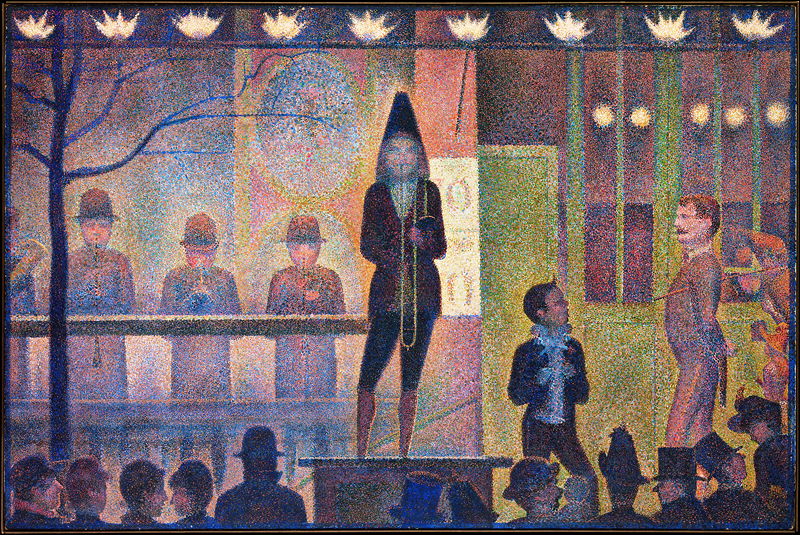
The painting features a row of tents and booths, along with a large crowd of spectators who have gathered to watch the various performances and attractions.
Seurat's meticulous pointillist technique is evident in the small, distinct dots of colour he used to create the composition. These dots of colour, when viewed from a distance, blend together to form the overall image and create a sense of luminosity.
Seurat's palette is vibrant and varied, reflecting the colourful nature of the circus. His careful use of complementary colours and juxtapositions of warm and cool tones demonstrate his deep understanding of colour theory and the principles of Divisionism.
The audience
One interesting aspect of "Circus Sideshow" is Seurat's focus on capturing the diverse audience. He portrayed individuals from different social classes and walks of life, each engaged in watching the performances with varying levels of interest. This attention to diversity was a characteristic feature of Seurat's work, aligning with his interest in social observation.
Where is it now?
The painting is now found in the collection of the Metropolitan Museum of Art in New York City.
"Circus Sideshow" exemplifies Seurat's dedication to meticulous technique, his exploration of color theory, and his ability to capture everyday scenes with a distinctive artistic approach. Through this painting, Seurat not only documented a specific form of entertainment but also provided a snapshot of society and human interaction during the late 19th century.
4. Camille Pissarro: The Apple Harvest (1888)
Camille Pissarro was known for his keen observations of rural life, landscapes, and everyday scenes, which he often depicted with a focus on light, colour, and atmospheric effects.
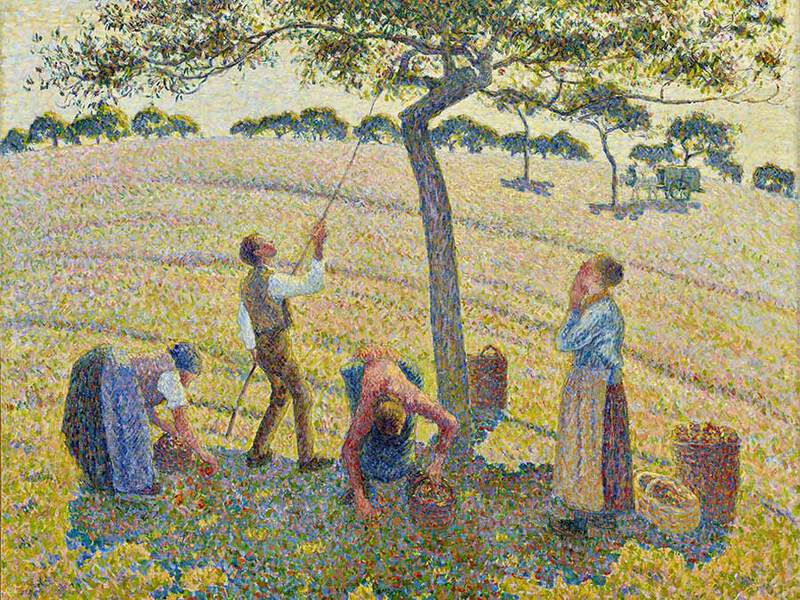
In "Apple Harvest," Pissarro captures the essence of a rural autumn scene during the apple harvesting season. The painting portrays a group of labourers, likely farm workers, engaged in the task of picking apples from the orchard trees.
The setting is imbued with the warm, golden hues of autumn, and the figures are shown in various poses, some atop ladders, others reaching for apples, and a few engaged in conversation or rest.
Pissarro's brushwork in "Apple Harvest" is at first blush characteristic of his Impressionist style, featuring loose and visible brushstrokes that capture the texture of foliage, the play of light on the leaves, and the movement of the figures. The scene is bathed in soft, natural light that filters through the leaves, creating a sense of tranquility and capturing the changing season.
But a closer inspection shows that Apple Harvest is in fact painted using the pointillist technique - look at the number of paint dashes on the canvass, and the contrasting colours.
The painting also showcases Pissarro's interest in depicting the interaction between people and their environment. He often focused on rural labourers and their everyday activities, giving a sense of authenticity to his scenes. "Apple Harvest" provides a glimpse into the lives of those who worked the land and participated in the seasonal cycles of agricultural labor.
Through his exploration of colour and light, Pissarro captures the atmospheric effects of the changing season. The painting's composition and attention to detail demonstrate his dedication to capturing the nuances of nature and human activity.
"Apple Harvest" is now found in the Dallas Museum of Art.
5. Georges Seurat: The Can Can (1889)
"Le Chahut" was created by Georges Seurat between 1889-1890, capturing the lively and energetic spirit of the 'can-can' dance and the French cabaret culture.
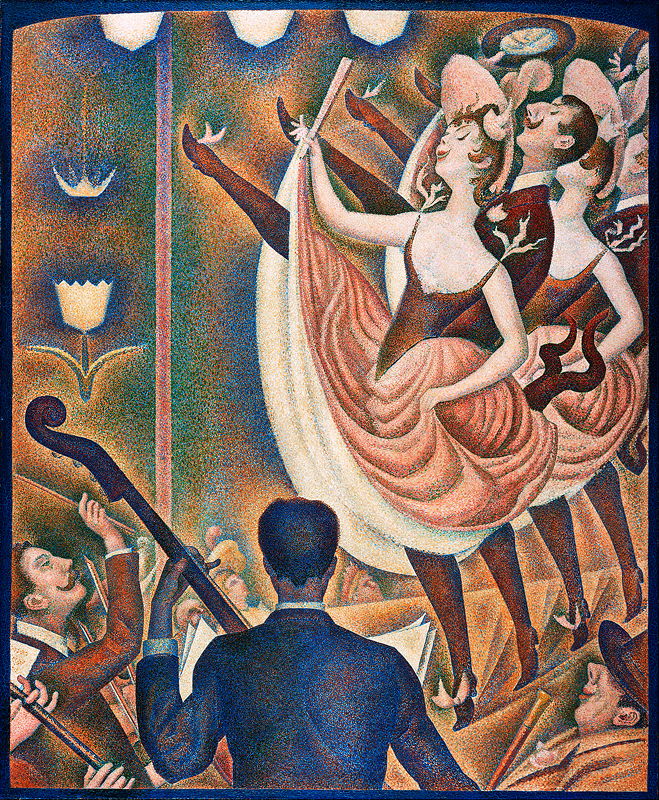
In "Le Chahut," Seurat depicted a scene from a can-can dance at the Moulin Rouge, a popular Parisian cabaret known for its vibrant performances. The painting features dancers in colourful costumes, engaging in the exuberant and rhythmic dance.
Interesting fact...
Closer inspection of the painting reveals two men (with pretty feminine legs) forming part of the dance line - and another man wearing a fedora hat in the bottom right of the motif seemingly looking up the skirt of one of the female dancers. Another unusual feature of the work is the fact that the principal musician has his back turned to the viewer.
Seurat's use of pointillism is evident in the way he applied small, distinct dots of colour to create a sense of vibrancy and luminosity. When viewed from a distance, these dots blend to form the overall image.
The title "Le Chahut" can be translated as "The Can-Can" or "The Dance." The painting captures the dynamic movement, enthusiasm, and social interaction of the dancers and their audience. Seurat's approach to capturing light and colour in this piece demonstrates his commitment to exploring the scientific principles of colour theory and optics through his artistic technique.
"Le Chahut" was certainly controversial: the can-can is a sexually charged dance and so many did not respond well to its endorsement by the artistic world. The painting is now found in the Kröller-Müller Museum in Otterlo, Netherlands.
6. Jaques Signac: Portrait of Félix Fénéon (1890)
"Opus 217. Against the Enamel of a Background Rhythmic with Beats and Angles, Tones, and Tints, Portrait of M. Félix Fénéon in 1890" is a famous painting by Paul Signac, completed in 1890.
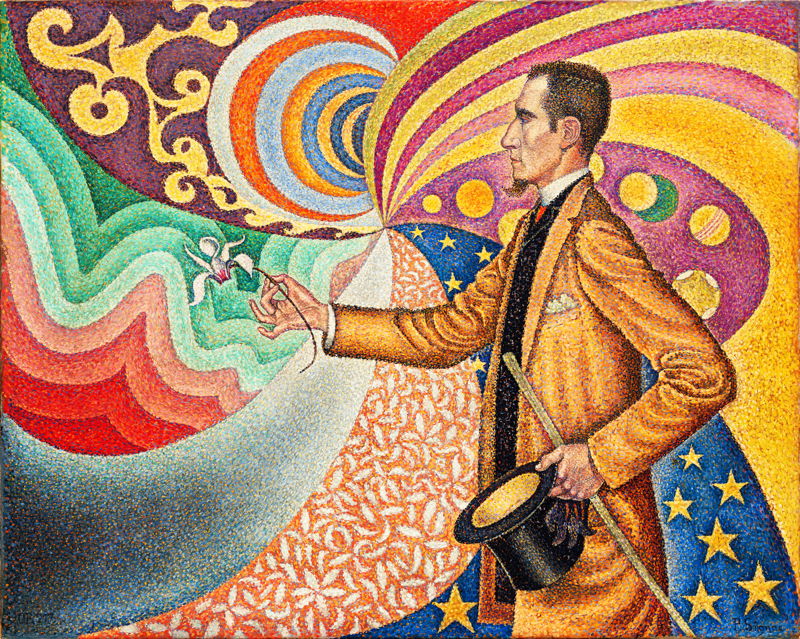
Félix Fénéon, the subject of the portrait, was an influential French art critic, editor, and anarchist who played a significant role in promoting and supporting avant-garde artists of the late 19th and early 20th centuries.
"Opus 217" showcases Signac's mastery of the neo-impressionist technique. The composition is dynamic, featuring Fénéon seated in a room with various decorative elements, including geometric patterns on the walls and a floral arrangement. The portrait captures Fénéon holding a top hat and contemplating a flower he holds in his right hand. The play of light and color on his face and the surrounding environment is achieved through the juxtaposition of tiny, individual brushstrokes.
The title of the painting, "Opus 217," suggests that it might have been the 217th work by Signac. The unusually lengthy subtitle, "Against the Enamel of a Background Rhythmic with Beats and Angles, Tones, and Tints, Portrait of M. Félix Fénéon in 1890," provides a vivid description of the composition and the atmosphere Signac aimed to capture.
The painting is not only a remarkable example of Neo-Impressionist technique but also a tribute to Fénéon's influence on the art world of his time. Fénéon's support for young artists, along with his sharp critical eye and involvement in avant-garde circles, left a lasting impact on the art scene. Signac's portrait commemorates Fénéon's role as a patron and promoter of innovative art.
Opus 217 is now found in New York's Museum of Modern Art.
7. Georges Lemmen: Plage a Heist (1891)
Georges Lemmen (1865-1916) was a Belgian painter who immersed himself in the pointillist movement before his early death.

Lemmen's Plage a Heist (Beach at Heist) depicts a sunset over sandy beach and serene sea. The viewer's attention is engaged by three points of interest:
- a solitary person standing on the beach, and seemingly looking along the shoreline rather than out at sea;
- a small sailboat grounded on the sandy beach; and
- a curiously shaped cloud - with a sharp horizontal line on its bottom and a mushroom forest seemingly growing out of it.
The overwhelming emotion that most viewers have when they look at Lemmen's work is one of calm.
Lemmen is a relatively unknown exponent of the neo-impressionist movement: he has, for example, no substantial Wikipedia entry. But he was a member of the influential group of Belgian artists known as Les XX; he started experimenting with art nouveau in the latter part of his career; and he died at the relatively young age of 51.
La Plage a Heist is now found in Paris' Musee d'Orsay.
8. Jaques Signac: The Demolisher (1899)
Signac's The Demolisher from 1899 is an interesting and controversial piece for a number of reasons.
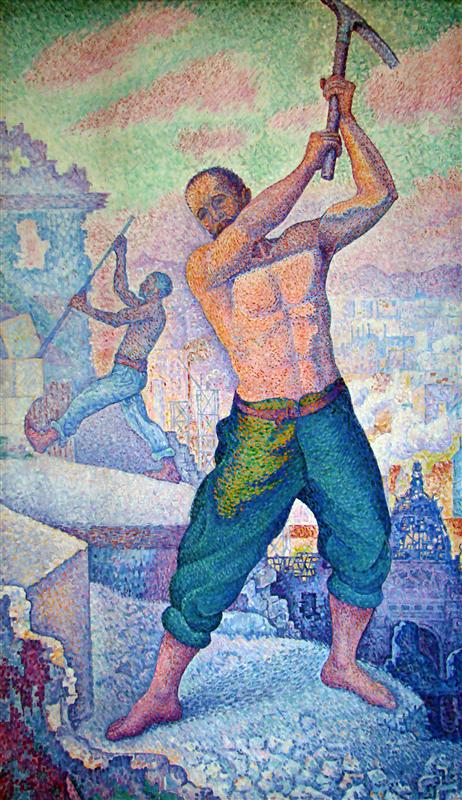
First, Signac paints bare chested men. Whilst naked or semi-naked females were common in the art world (for example Manet's Dejeuner sur l'Herbe and Olympia), male nudity was very unusual and frowned upon.
Second, Signac depicts an immigrant labourer in the mid-ground. This is almost certainly an observation on the use (and abuse) of immigrant labour that was commonplace in Paris at the turn of the 20th century.
Third, Signac shows a partially demolished Notre Dame in the background. Depicting an icon of the French state in this way was almost certainly intended to be an anarchistic statement - and it was certainly interpreted as such.
These days Signac's The Demolisher is found in Paris' Musee d'Orsay.
9. Henri Matisse: Luxury, Calm, and Voluptuousness (1904)
"Luxury, Calm, and Voluptuousness" ("Le Luxe, le Calme et la Volupté") is a painting by Henri Matisse, created in 1904.
It is considered a pivotal work in Matisse's career and is a significant example of his Fauvist style. It was also heavily influenced by pointillism.
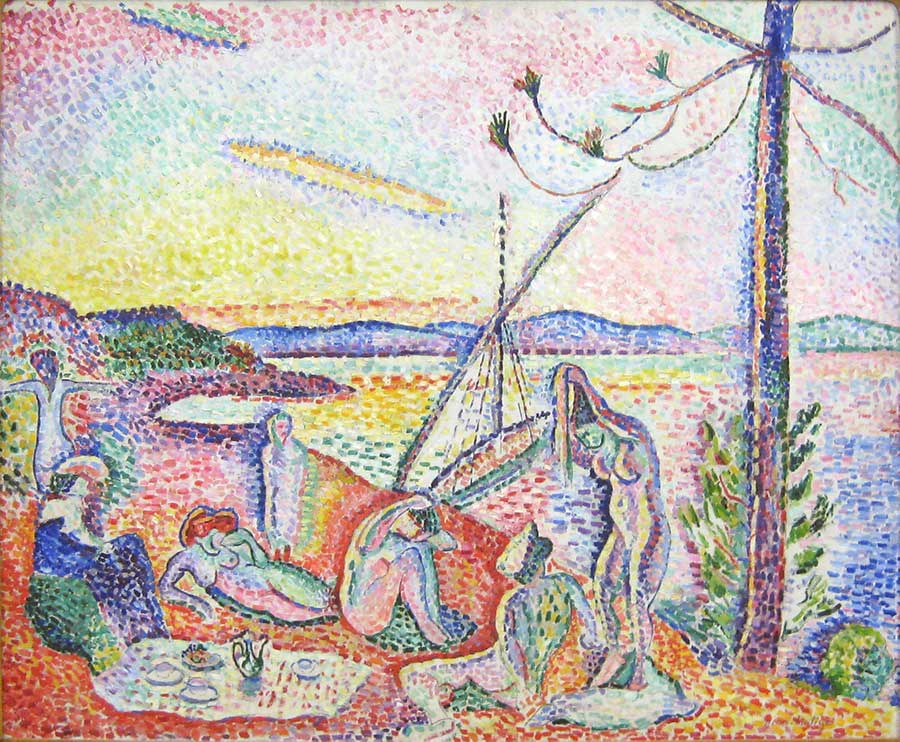
The painting features a serene and idyllic scene of leisure on the Mediterranean coast. It depicts a landscape with a shoreline, sailboats in the water, and a canopy of lush trees. The figures in the painting, which include three women and two men, are arranged in a way that suggests a languid afternoon by the sea. They are surrounded by an array of bold and vibrant colours that contribute to the overall emotional impact of the work.
The Fauvist movement, of which Matisse was a leading figure, was characterized by its use of vivid and non-naturalistic colours. In "Luxury, Calm, and Voluptuousness," Matisse employed this technique to convey emotion and atmosphere rather than strict realism. The colours are applied in broad, flat strokes, and they contribute to the painting's dreamlike and harmonious quality.
The title of the painting, "Luxury, Calm, and Voluptuousness," aligns with the tranquil and indulgent scene depicted. Matisse's choice of subject matter and title reflects his interest in capturing a sense of hedonism and leisure, inviting viewers to share in the relaxed and pleasurable atmosphere of the painting.
The work is heavily influenced by pointillism: though Matisse uses dashes rather than tiny dots, the use of contrasting colours can be seen throughout (it is particularly obvious in teh bottom left hand corner).
Matisse's work is now found in Paris' Musee d'Orsay.
10. Paul Signac: La Corne d'Or Matin (1907)
The painting "La Corne d'Or Matin" by Paul Signac captures the artist's fascination with the city of Istanbul during his visit in 1907.

Istanbul's grandeur, historical significance, and unique play of light and colour immediately struck Signac. This inspiration led him to create a series of twelve paintings centred around the Golden Horn, an estuary near Istanbul's port that held historical importance as an entrance to the Ottoman capital.
"La Corne d'Or Matin" features the recognisable skyline of Istanbul in the background, with the iconic minarets of the Hagia Sophia creating a distinct silhouette on the horizon. The cityscape, depicted in delicate pinks and purples, gives an ethereal quality to the painting.
The foreground is filled with a lively array of boats and ships in vibrant colors, conveying the bustling energy of the modern city. This composition showcases Signac's late style, which pays tribute to the city's history while infusing it with fresh vitality.
Signac's exploration of various port cities like Venice, Rotterdam, and London in the years leading up to his Istanbul visit was part of a deliberate artistic endeavour. His intention was to create a series of paintings featuring famous ports, akin to a series by Joseph Vernet. These later works moved away from his earlier focus on scientific modernity and embraced a decorative classicism reminiscent of past masters like Turner and Claude Lorrain.
While drawing inspiration from historical artists, Signac continued to experiment with technique. By 1907, he had evolved his style beyond strict Divisionism, which he had created together with Georges Seurat. In "La Corne d'Or Matin," Signac's mature technique is evident in his nuanced exploration of light and his expanded color palette, while still employing pointed brushstrokes characteristic of Divisionism.
The painting was the sole representation of Istanbul that Signac chose to exhibit at the 1908 Salon des Indépendants. Critics, such as Claude Roger-Marx, praised Signac's mastery of the new technique, emphasizing the high intensity of luminous and chromatic expression achieved through Neo-Impressionism.
In summary, "La Corne d'Or Matin" exemplifies Paul Signac's admiration for Istanbul's historical significance and its unique interplay of light and color. The painting is a testament to Signac's mature artistic style, which combines past influences with innovative techniques. Through this work, Signac pays homage to the city's heritage while infusing it with the vibrancy of his own artistic vision.
La Corne d'Or Matin was seized by the French state in 1988, displayed in the Musee d'Orsay from 2000, and returned to its rightful owners in 2018. It was sold by Sotheby's in London in 2020 with an estimate of £5-7 million.





